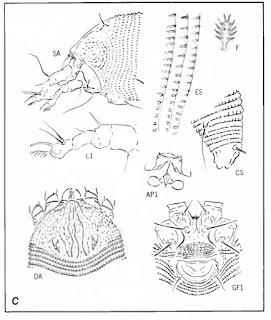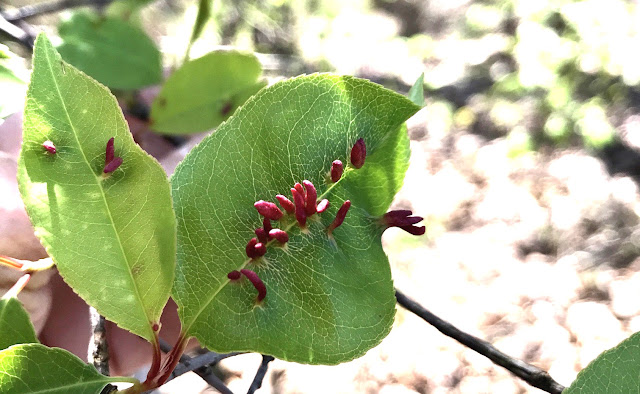If I had to pick a gall that is colorful with a unique look on it’s host, cherry leaf gall is my pick. As you can see by the photo, the bright red fingerlings protruding upright from the leaf are eye catching.
Microscopic Eriophyid mites are responsible for this creative work. The hollow galls are typically ⅛” to 5/16” long, so less than ½ inch. As you can see by the photo most of the galls crowd together along the midrib portion of the leaf. These galls happened to be red, but this same type of mite can produce yellowish green or brown galls. What factors cause the three color differences? Not all questions can be answered, not even by Google or Alexa.
This mite has two names. The easy and common one is black cherry finger gall mite. You guessed right! It is found exclusively on black cherry trees. The technical name for this mite is Eriophyes cerasicrumena. Might as well toss in the Latin name for its host plant - Prunus serotina.

According to a website based in Minnesota, there are several generations of galls each year with the first galls developing in April (coincided with my timing). The Minnesota Seasons website explains how the adult mites appear in three morphologically distinct forms. The overwintering female, a stage called deutogynes, resides in the tree’s leaf buds ready to emerge on the leaf as it grows in March.
Of course after a long winter, this mite is quite hungry so starts devouring the leaf with its microscopic mouth parts. The saliva has a chemical which causes the leaf cell to expand which forms the pouch. This deutogyne, finishes her business by entering the pouch, laying the eggs then proceeds to die. The May hatchlings are both males and females. This is where the third form comes into play.
The females that hatch in May are in the growing and eating stage called protogyne. These hatchlings will remain in the pouch into summer. According to research in the USDA Agricultural Handbook on mites, the gall is hollow and fleshy with moist tissue from water intake. Usually by July, the overwintering female appears inside the gall.
September is party time when the gall dries up and splits open releasing all three forms. The life cycle starts over with the overwintering female. "The mites are worm like, and have only two pairs of legs. Their primary method of population spread is by wind." Wikipedia
The life cycle of these mites might be interrupted by the cherry gall azure (Celastrina serotina). The larva of this butterfly feed on the galls and mites making it one of the rare species of carnivorous Lepidoptera. Bug Guide reports this butterfly's range to be northeastern United States and eastern Canada, so the Missouri galls should be safe from this carnivorous species.
You might want to look in the mirror for this next part. Sometimes internet searches on the blog topic provide more information than I care to know. I’m just thankful the mites that live on my face do not create galls.
=================================================================
Thanks Tonya for that interesting topic. Class is dismissed except for those bug nerds that would like to follow me further down the "rabbit hole" for fun.
 |
| Hackberry nipple galls - REK |
 | ||
| Click to enlarge P. cerasicrumena - USDA.gov |
Note to self - "Must go outside and get fresh air."
